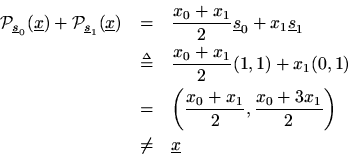NOTE: THIS DOCUMENT IS OBSOLETE, PLEASE CHECK THE NEW VERSION: "Mathematics of the Discrete Fourier Transform (DFT), with Audio Applications --- Second Edition", by Julius O. Smith III, W3K Publishing, 2007, ISBN 978-0-9745607-4-8. - Copyright © 2017-09-28 by Julius O. Smith III - Center for Computer Research in Music and Acoustics (CCRMA), Stanford University
<< Previous page TOC INDEX Next page >>
An Example of Changing Coordinates in 2D
As a simple example, let's pick the following pair of new coordinate vectors in 2D
These happen to be the DFT sinusoids forhaving frequencies
(''dc'') and
(half the sampling rate). (The sampled complex sinusoids of the DFT reduce to real numbers only for
and
.) We already showed in an earlier example that these vectors are orthogonal. However, they are not orthonormal since the norm is
in each case. Let's try projecting
onto these vectors and seeing if we can reconstruct by summing the projections.
The projection of
onto
is by definition
Similarly, the projection ofonto
is
The sum of these projections is then
It worked!Now consider another example:
The projections ofonto these vectors are
The sum of the projections is
Something went wrong, but what? It turns out that a set ofvectors can be used to reconstruct an arbitrary vector in
from its projections only if they are linearly independent. In general, a set of vectors is linearly independent if none of them can be expressed as a linear combination of the others in the set. What this means intuituvely is that they must ''point in different directions'' in
space. In this example
so that they lie along the same line in
-space. As a result, they are linearly dependent: one is a linear combination of the other.
Consider this example:
These point in different directions, but they are not orthogonal. What happens now? The projections are
The sum of the projections is
So, even though the vectors are linearly independent, the sum of projections onto them does not reconstruct the original vector. Since the sum of projections worked in the orthogonal case, and since orthogonalityimplies linear independence, we might conjecture at this point that the sum of projections onto a set ofvectors will reconstruct the original vector only when the vector set is orthogonal, and this is true, as we will show.
It turns out that one can apply an orthogonalizing process, called Gram-Schmidt orthogonalization to any
linearly independent vectors in
so as to form an orthogonal set which will always work. This will be derived in Section 6.7.3.
Obviously, there must be at least
vectors in the set. Otherwise, there would be too few degrees of freedom to represent an arbitrary
. That is, given the
coordinates
of
(which are scale factors relative to the coordinate vectors
in
), we have to find at least
coefficients of projection (which we may think of as coordinates relative to new coordinate vectors
). If we compute only
coefficients, then we would be mapping a set of
complex numbers to
numbers. Such a mapping cannot be invertible in general. It also turns out
linearly independent vectors is always sufficient. The next section will summarize the general results along these lines.









